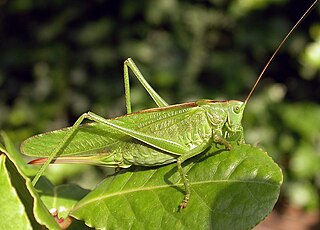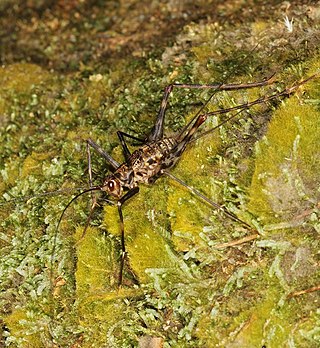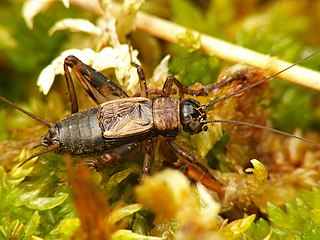
The orthopteran family Rhaphidophoridae of the suborder Ensifera has a worldwide distribution. Common names for these insects include cave crickets, camel crickets, Hogan bugs, spider crickets, land shrimp, and sand treaders. Those occurring in New Zealand are typically referred to as jumping or cave wētā. Most are found in forest environments or within caves, animal burrows, cellars, under stones, or in wood or similar environments. All species are flightless and nocturnal, usually with long antennae and legs. More than 500 species of Rhaphidophoridae are described.

Cooloola is a genus of ensiferan orthopterans known as Cooloola monsters. It is the only genus in the subfamily Cooloolinae and family Cooloolidae of the superfamily Stenopelmatoidea.

Bandwings, or band-winged grasshoppers, are the subfamily Oedipodinae of grasshoppers classified under the family Acrididae. They have a worldwide distribution and were originally elevated to full family status as the Oedipodidae. Many species primarily inhabit xeric weedy fields, and some are considered to be important locusts:

The Melanoplinae are a subfamily of grasshoppers in the family Acrididae. They are distributed across the Holarctic and Neotropical realms. They are one of the two largest subfamilies in the Acrididae. As of 2001 the Melanoplinae contained over 800 species in over 100 genera, with more species being described continuously.

Thaumatogryllus is a genus of crickets in the family Gryllidae. It was first described by British entomologist Robert Cyril Layton Perkins in 1899, with T. variegatus as the type and sole species. It currently includes four species, all known from the islands of Hawaiʻi.

The Tettigoniinae are a subfamily of bush crickets or katydids, which contains hundreds of species in about twelve tribes.

Aglaothorax is a genus of ovate shieldbacks in the family Tettigoniidae. There are about six described species in Aglaothorax.

Caconemobius varius is a species of cricket known by the common name Kaumana cave cricket. It is endemic to the island of Hawai'i, where it inhabits the dark zone of lava tube caves.

Zaprochilus, the twig-mimicking katydids, is a genus of bush crickets or katydids in the subfamily Zaprochilinae. They are found in Australia.

Phalangopsinae, occasionally known as spider crickets, are a subfamily of crickets in the family Phalangopsidae. Members of Phalangopsinae are found worldwide in tropical and subtropical regions. Most species in the subfamily are nocturnal and can be found in rocky areas, near fallen wood, and the understory of forests. Some species are gregarious, gathering in large numbers.

Tympanophora is a genus of bush-crickets, known as balloon-winged katydids, found in Australia. It is the only extant (living) genus in the subfamily Tympanophorinae.

Nemobiinae is a subfamily of the newly constituted Trigonidiidae, one of the cricket families. The type genus is Nemobius, which includes the wood cricket, but members of this subfamily may also be known as ground crickets or "pygmy field crickets".
Absonemobius is a genus of South American crickets in the subfamily Nemobiinae.

Bobilla is a genus of cricket in tribe Nemobiini, found in Australasia and the Pacific islands.
Microtettigonia is a genus of bush-crickets or katydids, endemic to Western Australia and known as micro katydids. It is the only genus of the subfamily Microtettigoniinae.
Cnemotettix is a genus of silk-spinning crickets in the family Anostostomatidae. There are about five described species in Cnemotettix.

Podoscirtinae is a subfamily of crickets in the family Gryllidae.
Anabropsini is a tribe of king crickets. The tribe comprises over 40 species, has a broad distribution in Old and New World tropics, including Asia, Africa, Oceania, Central America, and South America.
Allonemobius shalontaki, also known as the Choctaw ground cricket, is a species of ground cricket in the subfamily Nemobiinae. It is found in North America. The common name refers to the fact that the cricket was first discovered within the Choctaw Nation, and the species epithet means cricket in the Choctaw language.
Caconemobius fori, the Kilauea lava cricket, is a species of lava cricket endemic to the island of Hawai'i, where it is found on recently solidified lava flows produced by Kilauea and Mauna Loa.













